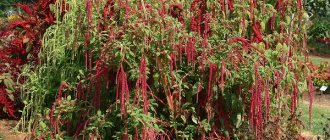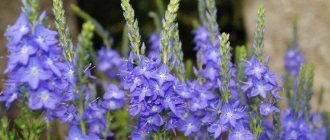Aubrieta is an excellent perennial plant for flower beds, rockeries and for planting along walls. This perennial will decorate the garden with numerous pink or purple flowers appearing at the turn of April and May, which almost completely cover the leaves, creating a beautiful, colorful cushion in a flowerbed, edge or rocky soil. In this article we will tell you how perennial aubrieta is used in the garden - planting and care in the open ground, methods of propagation, how to water and feed to achieve beautiful flowering of the plant.
Varieties and types of aubrietta flower
Aubrieta is an evergreen plant, which is a low-growing shrub. From the outside it appears as if a carpet covers the garden plot. The leaves have different shapes, resembling a lancet or ellipse. Their color is usually gray-green. The flowers are small, consist of four petals, do not exceed 1 cm in diameter. They can be regular, double or semi-double, and differ in shades.
Appearance of the aubriet
Among the numerous varieties and species of plants, the most popular are:
- Deltoid shaving. Blue or purple flowers appear in May and delight gardeners throughout the month. This is the most common type of plant, giving rise to almost all existing varieties. Due to the color of the flowers, it is known as the “lilac bush.” The leaves are characterized by a deltoid shape and have toothed edges, usually one or two. The shrub itself grows no more than 15 cm in height.
- Hybrid aubrieta or cultural. It blooms in spring, as if welcoming the arrival of sunny and warm days. Hybrid plants include artificially bred plants. Their flowers have a variety of shades; they can be red, white, violet, pink, purple. For example, the Audrey variety has several forms; the buds are raspberry or dark purple. The flowers grow so thickly, reminiscent of floating clouds, the names Giant Falls and Cote d'Azur speak for themselves. Some varieties have foliage that combines two shades.
- Graying shaving. Its leaves are distinguished by a silvery color, the flowers are usually light lilac.
- Aubrieta Columnar. Its stems are dense, thick, and fluffy pile is noticeable on the leaves. The flowers are also quite large, different from other varieties and species. They are usually pink or red.
- Aubrieta Campbell has large lilac flowers of different shades. They appear in May and last for more than a month.
Stunning Campbell variety
Planting a plant
To plant aubrieta you need seeds. They are either immediately placed in the ground or in special containers, waiting for the seedlings to appear. In the latter case, young shoots grow at home. They gain strength before landing in open ground. The main thing is to use suitable soil when sowing.
Planting by seeds
Coleus flower - care and cultivation in open ground
When growing aubretia from seeds, they are planted when night frosts are definitely not coming back. Usually this is May. You can also start the procedure in September.
Note! Autumn time is considered more preferable for planting. This is due to the large number of weeds in summer. They will interfere with the growth of the bush.
In order for aubrieta to bloom in the garden next year, cultivation from seeds should be carried out based on the recommendations:
- Treat the seeds with potassium permanganate, which will disinfect them. Then leave them in the growth stimulator for 10-12 hours.
- Prepare the planting site by digging and loosening the soil. If there is a large amount of clay, add sand. Get rid of stones so that the soil is homogeneous.
- Water the soil and make grooves leaving 15 cm between them.
- Place the seeds, cover with sand and moisten the soil.
- Cover with film until shoots appear. This usually happens within 2-3 weeks.
Planting seedlings
Perennial Aubrieta is planted for seedlings in February. The seeds must be treated in advance with a solution of potassium permanganate. This is an excellent antiseptic that gets rid of bacteria and fungi.
Abundant flowering plant
Evergreen obrietta, how to grow from seeds, step-by-step instructions:
- Prepare separate containers. It is better not to use boxes for seedlings, so as not to injure the roots of the plant in the future. They are fragile and try to avoid any manipulation with them.
- Fill the container with soil by mixing garden soil and sand in equal proportions.
- Place the seeds, sprinkle them with sand and moisten them a little.
- Cover with film and put in a warm place. The temperature at home should not fall below +18 ℃.
- Ventilate and moisten the seedlings daily when the soil dries out.
- Transplant into open ground in May, when the weather is consistently warm. Loosen and moisten the soil in advance. In order for young plants to be easily removed from containers, you need to put them in warm water for a while. This way the earth ball will move away from the walls more easily and you won’t have to injure the root system.
Proper planting of aubrieta is the key to its growth and abundant flowering. You need to sow in suitable soil and do not forget about the rules of moisture.
Reviews with photos about growing perennial aubrieta from seeds
Proskurina Veronica, 44 years old, Kurgan
It is not difficult to grow perennial aubrieta, but you need to take into account that the seeds are small. I immediately plant 5-6 pieces in one peat pot. Half of them will definitely rise. Of the total quantity, you need to leave 1-2 strong seedlings. Aubriet is afraid of transplanting, even if you make an earthen ball, you still don’t need to touch the small seedlings. It is better to grow without picking.
Malykh Anna, 56 years old, Volgograd
I plant the seeds of perennial aubrieta for seedlings immediately after my birthday - February 20. And I recommend everyone to do this, because they take a long time to sprout. They are small - you just need to scatter them on the surface, sprinkle them with Energen solution and press them a little more with a spoon. There is no need to cover it with soil. Grow at normal room temperature. The seeds of perennial aubriet are pre-germinated on a damp cloth for five days. If everything is done correctly, the shoots will sprout within 20 days.
Watering and loosening the soil
Anemones - growing and care in open ground
Watering the plant should be moderate. Be sure to monitor whether the soil is dry. Otherwise, the roots of the aubrieta will rot and die.
Note! If it is too hot outside and there has been no rain for a long time, the amount of watering is increased. But in any case, the procedure should not be carried out more than twice a week.
The soil needs to be loosened periodically, while sand is added to the top layer of soil. It is also necessary to get rid of weeds. Their growth has a detrimental effect on the development of obrieta.
Conclusion
Growing aubrieta from seeds is an accessible way even for a beginner to get a beautiful plant for your garden. If the described points of perennial agricultural technology are followed, problems with the growth of aubration will not arise.
Sources
- https://greensotka.ru/tsvetushchie/obrieta-vyraschivanie.html
- https://rastenievod.com/obrieta-aubretsiya.html
- https://moyasotka.com/tsvety/obrieta-aubretsiya-vyrashhivanie-iz-semyan-v-domashnih-usloviyah-kogda-sazhat.html
- https://flowergarden.pro/rassada-obrieta/
- https://fermilon.ru/tsvety/mnogoletniki/vyraschivanie-obriety-aubretsii-iz-semyan-kogda-sazhat-na-rassadu.html
- https://DachaMechty.ru/tsvety/aubretsiya-posadka-i-uhod.html
- https://chto-posadit.ru/obrieta-ili-aubretsiya-vyrashhivanie-iz-semyan-kogda-sazhat-posadka-i-uhod-v-otkrytom-grunte-foto-sortov/
- https://otsvetax.ru/obrieta-vyirashhivanie-iz-semyan-kogda-sazhat/
- https://klumba.guru/sadovye-cvety/kogda-sazhat-obrietu-aubreciyu-osobennosti-vyraschivaniya-iz-semyan.html
- https://MrDachnik.com/obrieta-ili-aubreciya
- https://dachnyuchastok.ru/vyrashchivanie-obriety-iz-semyan/
[collapse]
Reproduction methods
Sprekelia - cultivation and care in open ground
Most often, aubrieta is propagated by seeds or cuttings. Dividing the bush is rarely chosen; the roots of the plant are so fragile that they should not be touched again.
Cuttings usually remain after regular pruning of the bush. Shoots without flowers are placed in a mixture of sand and peat. It is necessary to create greenhouse conditions for them, and after rooting, transfer them to open ground. Typically, transplantation is planned for late summer or early autumn.
Feeding and fertilizers
Fertilizers should be applied when the plants have already grown, before the flowering period begins. It is also recommended to feed after pruning. Only nitrogen-containing preparations will not harm young flowers. They help increase green mass.
Much depends on the condition of the soil and its characteristics:
- If it is nutritious, then fertilizing is carried out rarely, 1-2 times a month is enough. Mineral fertilizers and mixtures containing potassium help the plant the most. You can purchase special complexes designed for flowering garden plants.
- When a flower grows among stones, you need to shorten the interval between procedures. In this case, when planting, the seeds are simply poured between the crevices of the cobblestones.
Aubrieta among the stones
Experienced gardeners recommend adding wood ash to the soil, and manure is considered destructive for shrubs. It can burn the roots of the plant and lead to its death.
How to care for aubrieta seedlings, what are the tricks?
Excessive soil and air moisture can destroy a perennial, so it is important for the gardener to strictly dose watering. It is advisable to moisten the soil through a tray. The soil surface is left dry. If watering from above, use a pipette or syringe, directing the stream away from the sprouts.
Basic parameters for growing seedlings:
- air temperature +20 degrees;
- lighting for 12-14 hours.
To prevent the development of rot, seedlings are watered with a solution of potassium permanganate or Fitosporin every 10-15 days.
The aubrieta seeds have sprouted, what to do next?
After the sprouts appear, the cover is removed from the crops. The soil is sprinkled with dry sand mixed with ash, without touching the seedlings. This technique prevents the appearance of rot and mold.
How to feed aubrieta seedlings?
Use only a mineral complex intended for flowering perennials (Kemira, Agricola). The concentration of the nutrient solution is twice as weak as recommended in the instructions. The frequency of fertilizing is once every 10 days, starting from the seedlings being one week old.
Rules for picking aubrieta
The plant does not tolerate transplantation well, so it is grown without picking. If such a need arises, the seedlings are picked up with a fork, along with a lump of earth. They are transplanted into a new substrate without destroying this lump.
Transplanting a plant
Aubrieta is an unpretentious plant and caring for it is not burdensome, but it takes transplantation extremely painfully. Often after the procedure the bush dies. Therefore, before growing an aubriette, you need to determine a place for it in advance so that the plant does not have to be disturbed later. Even the most experienced gardeners fail to save the life of a garden beauty. The procedure itself is carried out according to the usual rules, the bush is dug up and transferred to a new hole. The soil is moistened before planting, and after the flower is in place, sand is poured at the roots.
Characteristic
Aubrieta is a spectacular representative of perennial ground cover plants. The length of the stems can reach 25-35 cm. The shoots of the crop are divided into 2 varieties:
- vegetative, creeping along the surface of the soil;
- lateral branches rising upward.
Aubrecia pleases with lush flowering even when grown on poor soil
Thanks to the rapid growth of the crop, an oblong-shaped bush or a dense carpet soon forms on the site. Along the entire length of each shoot, one can note the presence of small pubescent leaves, naturally endowed with oval outlines or an obovate shape.
The leaf blades are attached to the stems by fairly short petioles. The outermost parts of the green mass can be either solid or jagged. Dense pubescence gives the green leaf blades a bluish tint.
At the end of spring, the bushes are covered with small flowers, which are arranged singly or collected in clusters. The flowering period usually lasts 40-55 days. The corollas consist of 4 bent petals, merging into narrow tubes, from which yellow anthers peek out.
The petals are painted in different shades:
- purple;
- pink;
- blue;
- white;
- purple.
After the pollination process is completed, fruit ovary begins - small swollen pods in which small seeds of a light brown hue are formed. They can be sown for further propagation. Information on how to grow aubrietta can be found below.
Pruning aubrietta
Pruning should be done several times a year. Be sure to do it after the first flowering, then by autumn the buds will set again. It is necessary to remove the stems of the bush almost at the very base, this is what will allow the plant to bloom annually.
Note! Before the aubrieta leaves for the winter, there is no need to trim the shoots. Otherwise, the flower will lose its strength and will not be able to withstand harsh weather conditions.
In the spring, before the growth period, you need to carefully inspect the bush, removing damaged and dried parts.
Pests and diseases
Planting and caring for perennial shrub does not require much time, because the flowering shrub cannot be called capricious. Another advantage of its cultivation is that it is rarely affected by diseases and pests.
Sometimes a flower becomes infected with powdery mildew. A whitish coating appears on the leaves and flowers under the influence of the fungus. After some time it acquires a brown tint. As a result, the affected areas turn black, rot and die. The bush no longer looks attractive; dry, ugly leaves and stems appear on the flowering carpet. In addition, an infected plant most likely will not survive the winter. The disease can be stopped, its spread can be stopped. Treatment with a solution of colloidal sulfur will help.
The inconvenience is caused by aphids, insects that suck the juice from the plant. It not only deprives it of nutrients, but also transmits viral diseases. The shrub needs to be treated with special means, for example, “korbafos”.
Flowering period
Aubrieta usually blooms in spring. The colorful period lasts for a month. Depending on the type of evergreen shrub, flowering begins in mid-spring or closer to summer. Sometimes it happens again, closer to autumn.
During flowering, it is important to retain moisture at the roots of the plant. To do this, the soil around the aubriet is sprinkled with sand. Abundant flowering is excluded if the soil is over-moistened. The bush requires a lot of liquid only during dry periods. The rest of the time there is usually enough rainfall.
Important! If the plant is watered too often, the foliage will be dense, and the flowers will appear inconspicuous against its background. In the worst case, the roots will rot.
At the end of the flowering period, a fruit is formed. It is a pod and the seeds are oblong in shape.
Preparing for winter
Aubrieta is a perennial plant; there is no need to dig it up. It tolerates winter well, but severe frosts can destroy the bush, so it is better to protect it.
Seeds and young shoots planted in the fall must be covered. Will protect the shaving from death:
- mulching with a mixture of sand and peat;
- dry leaves or spruce branches.
If the winter is snowy, the bush will not be damaged. In dry frosty weather there is a risk that it will die, so it is better to be safe. There is no need to remove leaves before wintering.
How to determine the time of sowing aubriet?
The perennial can be sown not only for seedlings, but also directly into the ground in the fall. The seeds are scattered over the garden bed at the end of October, so that seedlings do not appear before frost. Next spring, the aubrieta will show its leaves. The disadvantage of this planting option is the low germination of the plant.
To obtain seedlings, the ground cover is sown at the end of February - in March, 2-2.5 months before transplanting the bushes to a permanent place.
Use in landscape design
Aubrieta, as a ground-blooded flower, does not combine well with other garden plants. Low bushes look good in single plantings. They fill the area, resembling a fluffy carpet or a colorful sea. They are usually used in the design of garden and park areas for the design of alpine slides.
Flower in landscape design
An attractive plant is planted along paths, creating flower borders that divide the space. For such purposes, the cascade aubrietta from seeds is ideal; planting and caring for it is no different from other species. There are different varieties that differ in color, for example, Blue Shade, Cascade Red. The main thing is to place the flower in a sunny or slightly shaded place. Otherwise, it will lose its attractiveness, the petals will not be so bright.
It must be remembered that cascading aubrieta blooms a little later than other species. She loves moderate humidity, but is unpretentious to soil acidity. You can place the plant on the fence, going down, it will resemble streams of water, creating a bright waterfall.
In nature, aubrieta often grows near river banks and on rocks, so the shrub will feel great in rocky areas.
Aubrieta is an evergreen perennial. It blooms profusely and is easy to grow. It is a pleasure to look after him. As a reward for following simple rules, gardeners will receive a bright flowering carpet in the spring, and perhaps also in the fall. Aubrieta is difficult to replace in landscape design. The bush seems to have been created for alpine hills, because it exists comfortably even among stones.
brief information
Aubrieta belongs to the Cruciferous family. The Latin name of the plant is Aubrieta. This is where the second name comes from - Aubrecia. The perennial is named after the French landscape artist who loved to paint it. In Russia, a strange name for the plant has taken root - windbag.
It looks like a continuous carpet of blue, bright blue or lilac, with a height of 15 to 35 cm. Aubrieta loves well-lit areas. Grows well in poor rocky soils. Used for the design of alpine slides and rockeries, single plantings in gardens throughout Europe, Asian and Latin American countries.
Very beautiful single plantings of aubrieta are obtained on stone slides and fences. It grows well between stone steps and in the gaps of concrete slabs. Even in winter, the leaves of the plant remain green.
Creeping stems form vertical shoots, the height of which does not exceed 15-20 cm. Inflorescences appear at the tops of the shoots. Leaves have an entire edge, slightly elongated and pointed. They have a different location. Flowering begins in mid-April and ends in mid-June. In autumn another period of flowering begins.
Most often, the cultivated aubrieta Aubrieta cultorum, which is bred on the basis of the deltoid aubrieta, is used to decorate gardens and rock gardens.











